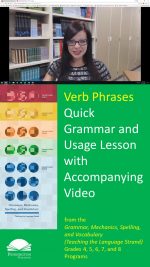Perfect Verb Tense
Perfect Verb Tense
Play the quick video lesson HERE and click the upper left back arrow to return to this lesson.
Common Core Language Standard 1
One of the best features of the English language is that we can say a lot in just a few words. Take our verbs for example. Even though we do have quite a few irregular verb forms, our different verb tenses more than make up for the minor inconvenience of memorizing the irregularities. Instead of having to surround verbs with lots of words to explain time and conditions, we just use change the verb tenses.
Today’s grammar and usage lesson is on the perfect verb tense. Remember that a verb can mentally or physically act or serve as a state of being. Verb tense indicates time.
Now let’s read the grammar and usage lesson and study the examples.
The perfect verb tense is used for a physical or mental action or state of being that refers to something that has already been completed. The perfect verb tense is formed with the past, present, or future tenses of the “to have” verb, the base form of a verb, and a past participle (“__d,” “__t,” “__ed,” “__ en”) ending.
- The past perfect refers to something that happened before another action in the past or something that happened before a specific time in the past. The past perfect is formed with had + the past participle. Example: had waited ‘til dawn
- The present perfect refers to something that happened at an unnamed time before the present. The present perfect verb is formed with has or have + the past participle. Examples: has waited since dawn, have waited every morning
- The future perfect refers to something that will happen before another action in the future or something that will happen before a specific time in the future. The future perfect is formed with will have + the past participle. Example: will have waited every morning
Now circle or highlight what is right and revise what is wrong according to grammar and usage lesson.
Practice: The teacher was started the unit last week. We have continued the lessons this week and will have been completed the unit by next Friday.
Let’s check the Practice Answers.
Grammar and Usage Practice Answers: The teacher had started the unit last week. We have continued the lessons this week and will have completed the unit by next Friday.
Now let’s apply what we have learned.
Writing Application: Write three of your own sentences: the first with a past perfect verb tense, the second with a present perfect verb tense, and the third with a future perfect verb tense.
This writing opener is part of a comprehensive language conventions lesson from the Grammar, Mechanics, Spelling, and Vocabulary Grades 4‒8 programs.
*****

Pennington Publishing Grammar Programs
Teaching Grammar, Usage, and Mechanics (Grades 4, 5, 6, 7, 8, and High School) are full-year, traditional, grade-level grammar, usage, and mechanics programs with plenty of remedial practice to help students catch up while they keep up with grade-level standards. Twice-per-week, 30-minute, no prep lessons in print or interactive Google slides with a fun secret agent theme. Simple sentence diagrams, mentor texts, video lessons, sentence dictations. Plenty of practice in the writing context. Includes biweekly tests and a final exam.
Grammar, Usage, and Mechanics Interactive Notebook (Grades 4‒8) is a full-year, no prep interactive notebook without all the mess. Twice-per-week, 30-minute, no prep grammar, usage, and mechanics lessons, formatted in Cornell Notes with cartoon response, writing application, 3D graphic organizers (easy cut and paste foldables), and great resource links. No need to create a teacher INB for student make-up work—it’s done for you! Plus, get remedial worksheets, biweekly tests, and a final exam.
Syntax in Reading and Writing is a function-based, sentence level syntax program, designed to build reading comprehension and increase writing sophistication. The 18 parts of speech, phrases, and clauses lessons are each leveled from basic (elementary) to advanced (middle and high school) and feature 5 lesson components (10–15 minutes each): 1. Learn It! 2. Identify It! 3. Explain It! (analysis of challenging sentences) 4. Revise It! (kernel sentences, sentence expansion, syntactic manipulation) 5. Create It! (Short writing application with the syntactic focus in different genre).
Get the Diagnostic Grammar, Usage, and Mechanics Assessments, Matrix, and Final Exam FREE Resource:
![]()



